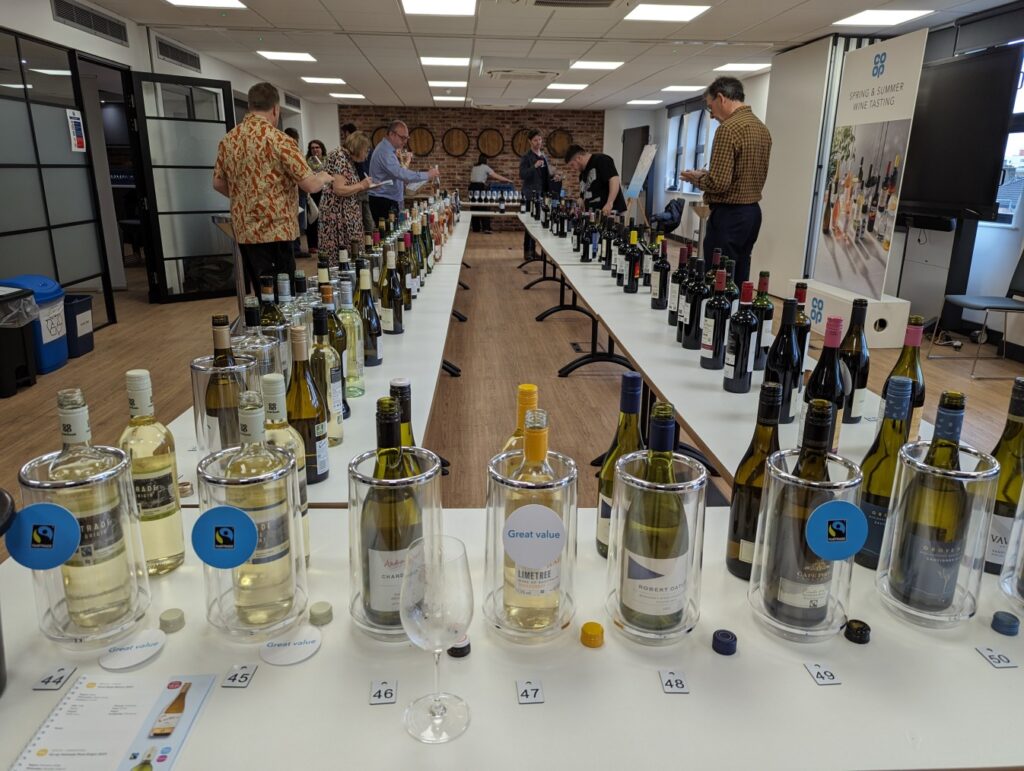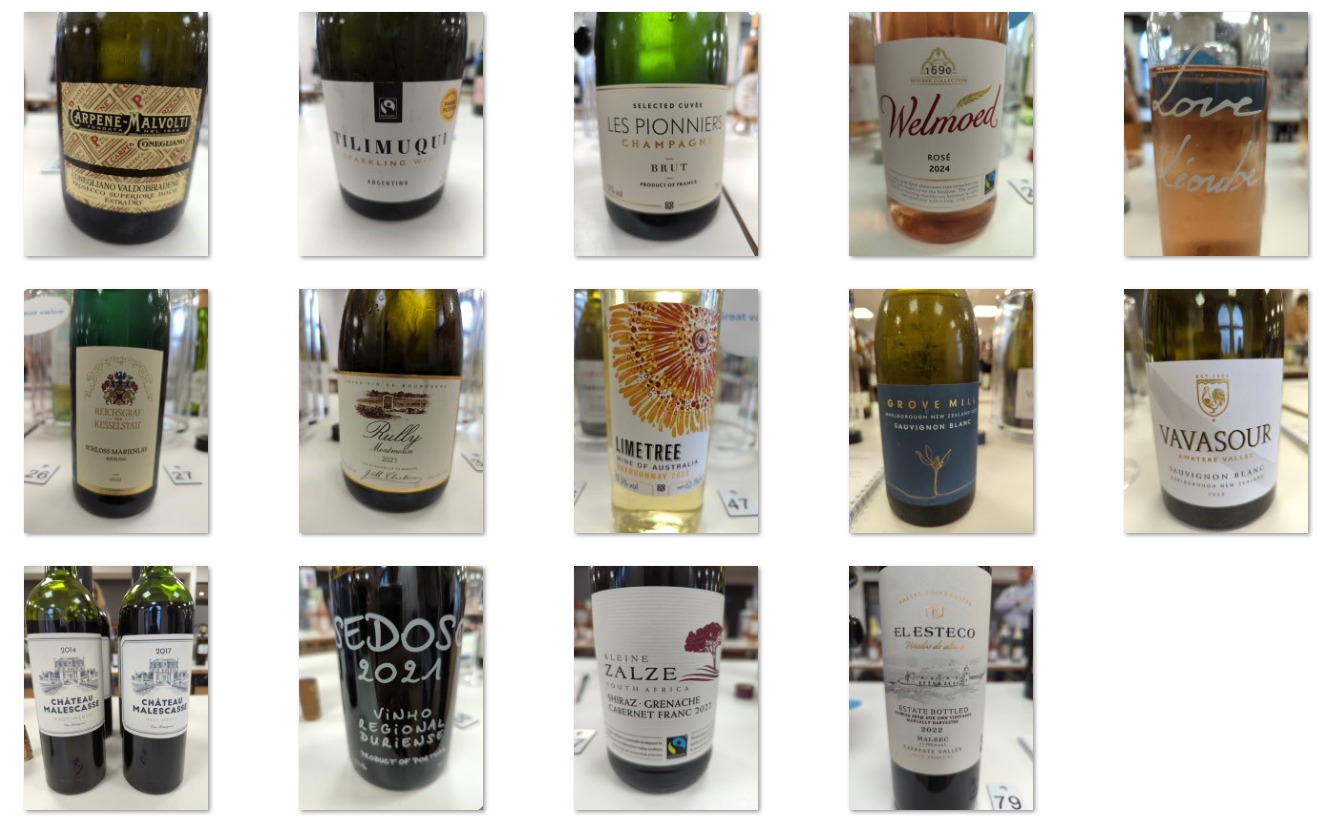
The Co-op Spring & Summer Wine Tasting was held in May 2024, in London, showcasing 84 wines.
With consumers becoming more price-conscious, the Co-op has seen a noticeable shift towards choosing own-label wines over branded ones. In response, Co-op has expanded its own-label wine ranges. There is also a strong demand for rosé wines, which, surprisingly, are popular year-round.
To make the wine section less intimidating, the Co-op is re-merchandising by arranging wines by grape type or variety and updating labels to use simpler language. These efforts aim to help customers make easier choices. The Co-op has also started online consumer wine tastings to better showcase the producers behind the wines, enhancing the overall wine experience for customers.
While there were lot of great wines, several wines stood out at the tasting, with a higher proportion of noteworthy selections than some other tastings, thanks to the excellent work of the Co-op buyers:

Carpenè-Malvolti Conegliano Valdobbiadene Prosecco Superiore D.O.C.G. 2023 11% £10.50
This wine stands out as a higher quality DOCG rather than a DOC. While DOCG wines typically have a richer and more complex taste, this quality is often lacking in many supermarket offerings I have tried. However, this wine is an exception. This particular wine is labelled ‘extra dry’, which actually means a sweeter Prosecco. The aroma is more perfumed, reminiscent of real peach rather than the typical ‘artificial’ peach scent of DOC. It has a fuller mouthfeel, more flavour and good length. Typically, a D.O.C.G. wine of this calibre would cost significantly more. This one is outstanding for the price.
Tilimuqui Sparking Brut NV 10.5% £9.50
This wine comes from Argentina and is made from 100% Torrontés grapes. Initially, I was unsure about it. However, I can see it appealing to many due to its slightly sweet, ‘bubble gum’ notes and attractive pricing. This is a new offering available in stores from 10th June.
Les Pionniers Champagne NV 12% £21.50
I have reviewed this previously. It remains excellent and is still one of my picks.
I tasted 17 rosé wines and ended up picking two at different ends of the price range:
Love By Leoube Rosé 2023 12.5% £17
This new offering from Provence is an organic blend of Cinsault, Grenache, Syrah, Carignan and Mourvèdre. Aromatic and flavoursome, featuring red berries, pomegranate and grapefruit. This wine stands out as the premium option.
Welmoed Rosé 2024 12.5% £7.65
A South African wine made from 100% Shiraz grapes and slightly darker than usual. It features notes of strawberry and apple, with a stronger taste that is its main distinguishing feature. Offering excellent value, it is a good choice for those seeking robust flavour at a reasonable price.
Von Kesselstatt Mosel Riesling 2022 10% £12.50
Made from 100% Riesling grapes, has an intense aroma and taste. It is off-dry, featuring refreshing grapefruit, peach and lime flavours, all backed by crisp acidity. A vibrant and invigorating wine experience.
Rully Montmorin Blanc, Domaine Jean Chartron 2021 13% £30
This new, 100% Chardonnay, wine from Burgundy provides an enticing apple aroma and a creamy taste with notes of nut, lemon and a hint of spice. Unlike overly oaked Chardonnays, this one strikes a gentle balance, making it an outstanding choice.
Limetree Chardonnay 2023 12.5% £6
Made from 95% Chardonnay, 1% Verdelho, 1% Shiraz and 3% other varietals. It offers notes of stone fruit and vanilla. Positioned at the other end of the price spectrum compared to the previous Rully, it is surprisingly good for its price. A perfectly acceptable option for the budget-conscious.
Grove Mill Sauvignon Blanc 2023 12.5% £10.50
This New Zealand wine features classic tropical and passionfruit notes, delivering a clean and crisp taste. Initially, I thought it was an exceptional find, until I tasted the next one…
Vavasour Sauvignon Blanc 2023 12.5% £11.50
Again from New Zealand. This wine has deeper aromas, flavours and is more complex than the Grove Mill, without becoming too musky and muddled, making it an outstanding choice.
Château Malescasse 2014/2017 14% £25.50
This Bordeaux blend consists of 54% Merlot, 36% Cabernet Sauvignon and 10% Petit Verdot, with a mix of vintages currently available in stores. It features intense red fruity notes and good tannins. The 2017 vintage seemed slightly more fruity.
Sedoso 2021 11% £8.50
This new Portuguese wine is distinctive, with bottle markings reminiscent of Port. It is made from Tinta Roriz, Touriga Nacional, Touriga Franca, Tinta Barroca and Tinta Cão grapes. Featuring blackcurrant notes and medium tannins, it is a more sophisticated, grown-up version of Porta 6.
Zalze Red Blend Fairtrade 2022 14.5% £8.75
This new South African wine is a blend of Shiraz, Grenache and Cabernet Franc. It offers fruity plum and spice notes with a good finish. Excellent value, making it a great choice for the price.
El Esteco Malbec 2022 13.5% £13.50
A new inky, Fairtrade, Malbec. It features ripe black stone fruits, hints of violets, mocha and cacao. Although I don’t usually favour Malbec, I found this one outstanding and highly enjoyable.
Note that not all wines are available in all stores and prices are subject to change.













